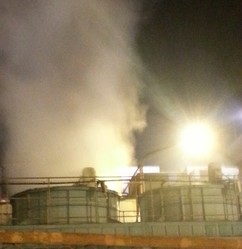Among numerous forms of environmental pollution, light pollution is probably the least recognized type. Although light pollution does not seem to be as detrimental to health as air or water pollution, it is an environmental quality problem with several negative implications for humans, animals and birds. Simple control measures can resolve the problem, thereby saving energy and cost.

Light Pollution: Causes, Impacts and Control Measures
Excessive, poorly directed or obtrusive artificial light causes hostile effects on living beings. Simple steps can resolve the problem offering environmental and financial benefits
What Causes Light Pollution and How Can We Control It?
What is Light Pollution?
Also known as luminous pollution or photo pollution, light pollution refers to excessive or misdirected artificial light that alters the natural night sky. It is caused by misdirected and poorly designed light sources. Light pollution occurs in a number of forms:
- Glare from un-shielded lighting
- Light trespass: unwanted light enters one’s territory just like light entering in one’s bedroom at night time
- The reduced visibility at night is often a consequence of an atmospheric phenomenon known as sky glow. The light emanating from poorly designed or inappropriately directed lamps such as flood lights gets reflected and scattered from liquid and solid particles suspended in the air; as this light returns to the eyes of the people on ground, it obliterates their view of the sky.
Impacts of Light Pollution
Glare from security flood lights, road lamps and misdirected yard lights can cause discomfort for many people. Excessive light can affect our body cycles causing sleeping disorders, severe headaches, stress, anxiety and obesity; some think it may lead to cancer as well.
Light pollution reduces the visibility of stars and other heavenly objects, thus causing difficulties for amateur and professional astronomers. Since nocturnal lighting consumes electricity, which is often generated by burning of fossil fuels, light pollution contributes to air pollution in an indirect way.
Light pollution can also have adverse impacts on animals and birds. For instance, many migratory birds use the light of moon and stars for navigation at night. Nonetheless, as they fly past urban and suburban areas, they might be disoriented by excessive glare from artificial light. As a consequence, migrating birds often collide with tall sky scrapers and die.
Light pollution is also accused of disrupting ecosystems especially affecting nocturnal wildlife; for instance undue night light is said to pose profound impact on sleep/awake cycles of insects; nevertheless, scientists are pursuing to collect some conclusive evidence in this regard.
Controlling Light Pollution
Light pollution can be reduced by using properly designed, energy-efficient light fixtures aimed at directing the light downward. By using this approach, lights with lower wattage can be used resulting in significant energy and monetary savings. Alternatively, the number and brightness of lights can be reduced, thereby reducing unwanted glare and increasing visibility effectively.
Use of low pressure sodium (LPS) light sources for street lighting, parking lot lights and security lamps is also useful in minimizing the adverse effects on astronomical activities. Not only they reduce sky glow, they are one of the most energy-efficient light sources.
By enforcing appropriate laws and regulations, communities, parks, and even entire countries can cater the problem of light pollution effectively.
Sources:
- 2011, Curley, Robert, New Thinking about Pollution, Britannica Educational Publishing.
- 2004, Pollution, A to Z, Thomson Gale.
- Globe at Night, What is Light Pollution, retrieved on 29th June, 2015.
You might also like
Greening the WatersPurifying the polluted waters of the Humber Estuary requires working with nature



 Lise Meitner: The Neglected Woman Scientist Who Discovered Nuclear Fissionon 06/28/2015
Lise Meitner: The Neglected Woman Scientist Who Discovered Nuclear Fissionon 06/28/2015

Comments
@WriterArtist: Thanks for reading; glad you liked it.
@frankbeswick: You have certainly highlighted a few interesting projects; for fighting any form of pollution, collective efforts are the key.
I only realized the degree of light pollution to which I had been subject in the metropolis in North West England in which I was raised when I moved temporarily to the West of Ireland at the age of nineteen and saw the night sky in all its glory for the first time.
In Britain we are obviously a crowded, urbanized island, but we have established a research project to identify and protect areas where the sky is unpolluted by light. There is a similar project to identify and protect areas where there is no noise pollution, and one area, in rural Northumberland, England's most north easterly and least populated county, has areas that fall into both categories. The Northumberland moors are remote and barely inhabited places.
This subject is grossly underrated and I learnt a lot today about light pollution. Certain aspects of light that are harmful are in need to be addressed as soon as possible.
Thanks for your comment; you have highlighted an important facet of light pollution.
I am well aware that to see the stars properly using a telescope one must go to a dark, rural place. scattered light from streetlights is enough to cause a problem.
One other thing that is actually dangerous, yet done by some cities is the use of traffic cameras. The lights used to illuminate the license plate of the targeted vehicle blinds drivers coming the opposite way when flashed at night. The eyes cannot react fast enough. During the day, they are not so intrusive. One day there will be a terrible accident, and some politicians may be charged. Either they should be narrow beams well directed or turned off. Some streets look like lightning storms, blinding drivers all along the length of the road.
Thanks a lot for reading and commenting. In our quest for our modern living standards, we are certainly compromising sustainability of future generations.
We see a big difference in the visibility of the night when we visit our family farm. And there's an even bigger one when we are on a ship out at sea. So, I can certainly relate to the subject of your article.